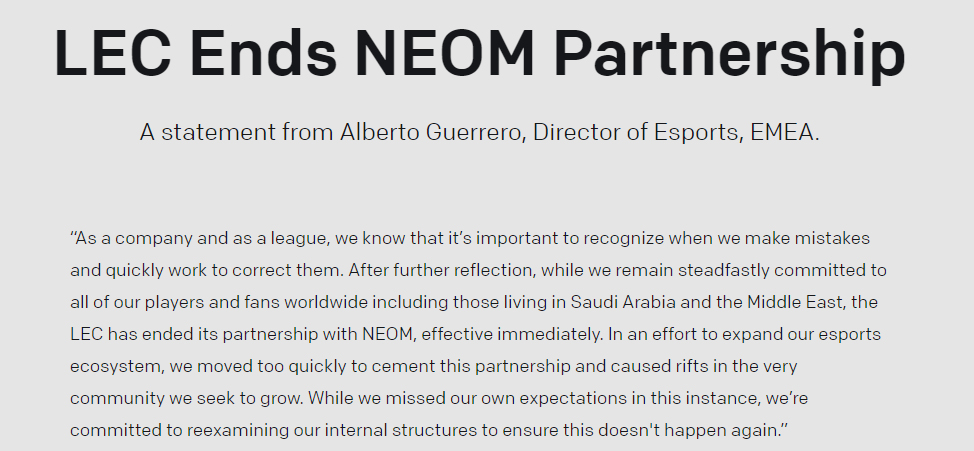Tobias M. Scholz is an Akademischer Rat (equivalent to Assistant Professor) for Human Resource Management and Organizational Behavior at the University of Siegen in Germany. He has been involved in esports since 2001 and is the founding chairman of the Esports Research Network.
It was a turbulent time for esports when the League of Legends European Championship and BLAST announced partnerships with NEOM, a Saudi-Arabian city project; especially the outcry from the audience of the LEC as well as its on-air talents was striking. However, this commentary is not about this process (you can read more about it here), but why this is an interesting case for the effect of organizational culture as well as the strategic coherence on the business and subsequently, the business model. There is a sociopolitical layer on the topic, but we want to take a step back and look at it from a strategic management perspective.
LEC had to deal with massive backlash from its customers and employees because, prior to this particular announcement, it coherently showed an inclusive and diverse strategy. The league even fostered this with its own take on pride week and obviously attracting talents that have different “sexual orientation.” From the outside, having a staff that embraces its diversity is always a sign of a diverse and inclusive work environment. Therefore, it becomes evident that the organizational culture embraces diversity and inclusion. This is important for one key reason: Diversity is a cornerstone of the LEC culture. BLAST, however, may not necessarily stand for diversity or inclusion, as it is not an integral part of its cultural values.
In the literature on organizational culture, it is no surprise that these values have an impact on everything in an organization. This interaction is often described in the LAMBDA model. Any organization has a hidden level that describes the cultural core values of a company and is depicted in the organizational culture. What makes the company different from other competitors? This might be its customer focus or even its innovational risk-taking. The LEC embraced the diversity issue and over time it became a cornerstone of the organization. Therefore, it became observable and shaped the organizational appearance. A most striking example of having a LEC pride logo. This appearance is visible for employees and customers likewise. Thereby, the organizational image is shaped by these cultural values depicted by the organizational culture and “exemplified” by the employees.
The organizational image is also hidden as it is derived by everybody from the outside, be it the customers or competitors or, in the case of the LEC, even the teams playing in the LEC. The organizational image is a perception of the LEC and, subsequently, a reflection of its action. Just to clarify why a distortion can be harmful: A misfit between organizational culture and the organizational image is often observed when a whistleblower reveals misconduct in companies that try to practice greenwashing.
The LEC did a splendid job of having a coherence in its strategy that led to a perfect fit between the organizational culture and the image. However, the NEOM deal fractured this fit and highlights that the hidden level of culture and image is extremely important for any organization. It will be interesting to observe, how the LEC will deal with this situation, but it is a striking example that embracing certain cultural values is relevant for attracting and keeping certain employees as well as retaining specific customers. Therefore, cultural values influence the business model and any strategic decision needs to be coherent.
BLAST, on the other side, is not observed as being a diverse or inclusive organization. Therefore, the backlash is not that big compared to the LEC and it will probably keep the partnership. BLAST can economically live with losing some people and some reputation, but the loss is definitely less than what they get out of the partnership. Somewhat ironically BLAST is strategically coherent in that process in contrast to the LEC, that went against its cultural values.

Any organization needs to know, for what they stand. For sure, this is not unique for esports and many non-esports companies to struggle with, but with an increase in professionalization, esports companies represent values, if they want it or not. These values are often hidden and emerge over time, but strategic decisions need to factor the organizational culture and image into it in order to minimize the potential risk of a public backlash. The LEC did a great job to promote diversity and inclusion, but now has to deal with the criticism for purplewashing.
In the end, LEC dealt well with the backlash and did good damage control. At least from the strategic management perspective, it might have been preventable from the beginning. Utilizing certain cultural values may lead to an increase in profit and expanding reach, but this comes with the price that these values need to be exemplified authentically (Something we also saw with the Hong Kong-Blizzard case). The main lesson from this situation is that esports companies are now big enough that they have to understand their own organizational culture and what their values are. Furthermore, they are old enough to have a specific organizational image in the esports ecosystem. Understanding these hidden values may lead to authenticity that can be utilized, however, neglecting or going against these values will lead to significant backlash.